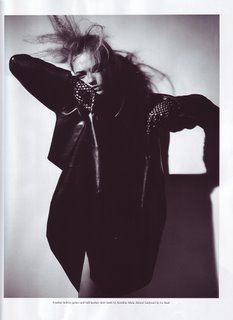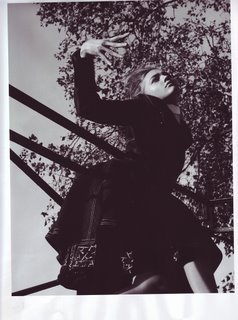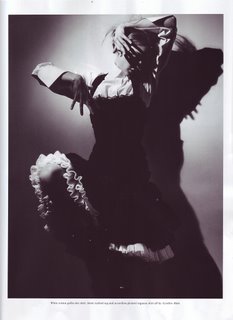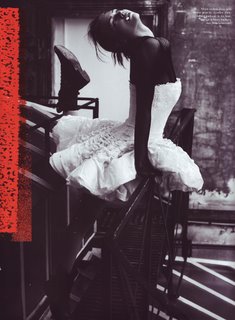Her assailent:"An a whata"
Cher:"It's like a totally important designer"
10 Years Ago, Alaïa Launched His Revolution : Landmark for King of Curves
By Suzy Menkes International Herald Tribune
Tuesday, September 3, 1991
If there were any justice in this (fashion) world, Azzedine Alaïa would be a worldwide household name, instead of a cult hero. It is 10 years since the small, shy, Tunisian-born designer launched the body-conscious stretch looks that have defined the way an entire generation dresses and become the fashion revolution of the last decade. .

"Ten years? Yes, it is ten years!" said Alaïa at his Paris studio in the Marais, where he will open a boutique (decorated with panels by the New York painter Julian Schnabel) this month. While other designers celebrate landmark years as rites of passage, Alaïa will not be marking these first 10 years. Nor does he even admit the overwhelming influence on fashion of his ideas. .
"Who can really say who invents something first in fashion?" he says. "I had used the stretch materials for years to shape the inside of garments I made for private clients. Then I just started using them on their own. And look at the corset effects I have done in my new collection. They go back to the 18th century, even if no one had done them in knit before." .
The corsets in question include a lightly-boned version of the "body" - the one-piece foundation that was another of Alaïa's gifts to the fashion world. Other outfits in his new collection are made with a network of openwork seaming tracing the shape of the body without constricting it and revealing flesh in a subtle way. The thrust of the top halves is designed not just for sex appeal (although that never seems far from Alaïa's fashion vision), but also to balance the new mid-calf lengths. The designer who was the master of the skimpy skirt, showed, in a big collection, almost entirely skinny skirts falling to mid-calf. .
"IT is time to change," he says. "But you have to show them with high heels, or the long length looks drab." The alternative was a shorter skirt, flared at the front, cut on the bias, with a wrap at the back - a masterpiece of fashion origami that shows the designer's technical skill with the scissors. .




Alaïa, who originally studied sculpture at the Ecole des Beaux Arts in Tunisia, and worked briefly with Thierry Mugler, launched his clingy line in 1981 - at the moment when fashion was entering the oversized, androgynous era. His body-conscious clothes seemed a deliberate challenge - throwing down a sexist gauntlet in a feminist world. The first collection included riveted gauntlets in the glove-soft leather that has become one of the hallmarks of his designs. Big leather riding coats and curvy wool jackets - shown this season with the skinny skirts, 1940s hairstyles and high-heeled ankle boots - are the commercial heart of Alaïa's line. Ah commerce! It is hard to believe that Alaïa himself has ever made a commercial decision. While the mass-market has fed off his clinging styles for at least seven years, he works in the back room, head down, perfecting the patterns that he cuts entirely himself. His lack of interest in self-promotion is legendary.
He does not speak English. He does not like airplanes. Another designer might have used his power as King of the Curves to take on quick-buck licensees for undies, swimsuits or exercise clothes - or even raised backing for a chain of boutiques. Alaïa prefers to work to his own standards and an idiosyncratic time scale. As it is, Bergdorf Goodman (which stopped carrying the line in 1985 after a contretemps with the designer) will put Alaïa back in the store this fall. The autumn collection was shown months after all other designers, who present in March, on a steamy Saturday night at the end of July, when the entire fashion world had left for vacation. Only the unswerving loyalty of the world's top models - Christy Turlington, Claudia Schiffer, Naomi Campbell, Elle MacPherson - kept them in town. Alaïa was the first to put them on the runway, thus starting yet another fashion trend of making models into superstars.
He created a fluffy-bunny white outfit in which Naomi Campbell paraded mouthing the words of her newly launched pop record. The recurring themes of the collection were the shapely tops and long skinny skirts, leopard prints and fabrics with a tactile feel, from fake fur, to a new boiled-up knit and sloppy Joe tunic sweaters in fruits-of-the-forest colors: hawthorn orange, bilberry and cranberry. "There is a sensuality about fabric," says Alaïa. "I think all materials should be inviting when they touch the skin. When I watch children stroking their mother's clothes, I feel that I have succeeded." ALAIA'S secret - and the reason why his clothes have such a faithful following - is his research into materials and above all the way he cuts them. "Although I was working with stretch from the beginning, I never made tubes," he says. "Jersey was always cut and pieced together. And these knits are not printed; the jacquard knit is worked to make the pattern fall like this." He is holding a body suit with a butterfly motif, inspired by Arletty, who is one of his heroines.
The suit sashayed down the runway spreading colorful wings across each buttock. Copyists would just splash on a print to give the same effect - but not, of course, the same fit. The irony of Azzedine Alaïa's work is that whereas his look has been molded to the mass market by using Lycra, his own versions are painstakingly crafted with traditional dressmaking skills.
Alaïa started his career as a dressmaker whose name was passed by word of mouth among chic Parisian women. And he still has as clients or customers women who look to him to iron out or reshape the little bulges. So while many women have rejected the body-hugging look as only for the young with beautiful bodies, the unsung fashion hero who started it all aims to dress every woman so that her body looks a cut above the rest.
No comments:
Post a Comment